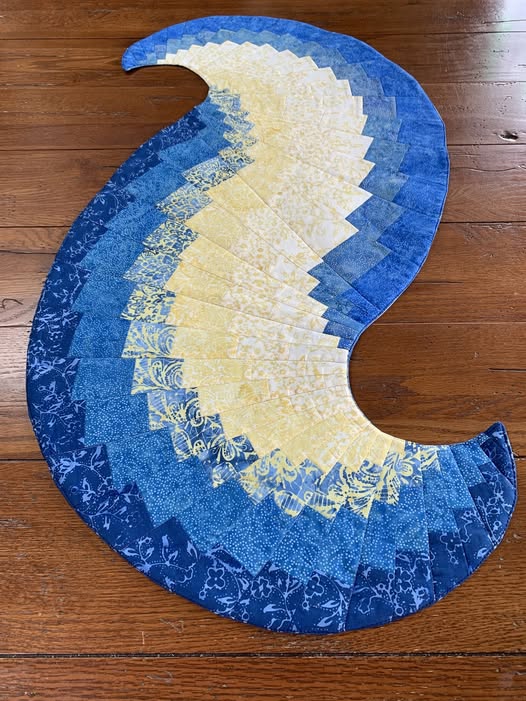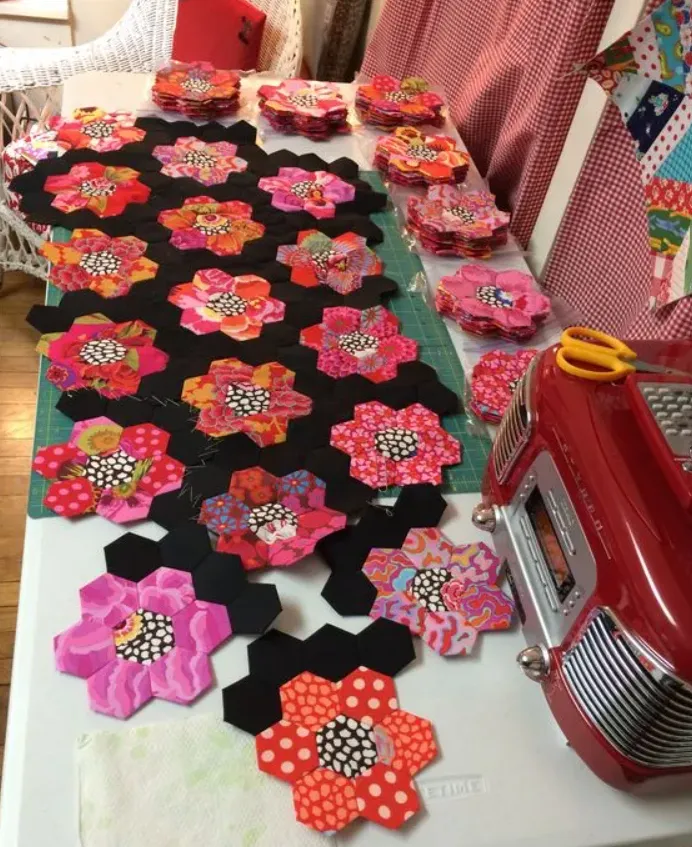
The Hexagon Flower Quilt Block has long been celebrated in the world of quilting for its timeless elegance and intricate design.
From seasoned quilters to beginners, this pattern captures the essence of traditional quilting while allowing room for creative expression.
Known for its six-sided symmetry, the hexagon shape provides a versatile base that can be adapted into various floral patterns, making each quilt block unique and visually appealing.

Understanding the history and techniques behind the Hexagon Flower Quilt Block is essential for anyone looking to enhance their quilting skills or create heirloom-quality pieces.
Quilting enthusiasts often choose the Hexagon Flower Quilt Block because it combines both aesthetic charm and technical challenge. Unlike simple square blocks, hexagons require precise cutting and piecing to ensure perfect alignment. This block encourages quilters to refine their hand-sewing skills, particularly in creating smooth curves and sharp angles that define each petal of the flower design. Additionally, the Hexagon Flower Quilt Block is highly versatile; it can be incorporated into larger quilts, table runners, or decorative wall hangings, making it an enduring favorite in quilting circles.
Moreover, the Hexagon Flower Quilt Block is not just about technique; it is a form of storytelling. Many quilters use this pattern to commemorate special events, family milestones, or personal journeys. The choice of colors, fabric textures, and the arrangement of hexagons allows each piece to convey a unique narrative. Understanding the significance of the Hexagon Flower Quilt Block in both historical and modern quilting contexts enhances the appreciation of its beauty and craftsmanship. This article will explore the techniques, materials, design variations, and practical applications of this iconic quilt block.
The Hexagon Flower Quilt Block is a geometric pattern composed of six-sided shapes meticulously arranged to form a flower-like motif. Each hexagon serves as a building block, fitting seamlessly with its neighbors to create a larger, cohesive design. One of the main attractions of this block is its adaptability: it can be made from scraps for a scrappy quilt or from carefully coordinated fabrics for a more formal quilt design.
Creating a Hexagon Flower Quilt Block requires a solid understanding of basic quilting terms and techniques. English paper piecing (EPP) is a popular method for assembling these blocks, as it ensures precision and durability. This technique involves wrapping fabric around a paper template, stitching the pieces together by hand, and then removing the paper once the block is complete. For quilters who prefer machine sewing, hexagons can also be sewn directly using careful seam alignment and strategic pinning.
The color scheme plays a crucial role in the visual impact of the Hexagon Flower Quilt Block. Quilters often choose contrasting fabrics to highlight the flower motif or subtle shades to create a soft, vintage look. By experimenting with light and dark tones, quilters can produce blocks that appear three-dimensional and dynamic. Understanding color theory and fabric selection is essential for achieving the timeless elegance that this block is known for.
Design variations of the Hexagon Flower Quilt Block are almost limitless. While the classic arrangement resembles a blooming flower, modern quilters have introduced asymmetrical patterns, gradient color schemes, and mixed fabric textures. Each variation brings a fresh perspective to the traditional design while maintaining the block’s geometric integrity. This versatility makes the hexagon flower pattern a favorite among both traditionalists and contemporary quilters.
Precision is key in constructing the Hexagon Flower Quilt Block. Small inaccuracies in cutting or stitching can lead to misaligned seams and uneven patterns. Tools such as rotary cutters, acrylic templates, and seam guides are invaluable in maintaining consistency. Attention to detail ensures that each block can be seamlessly integrated into larger quilts, resulting in a polished, professional finish.
Finally, the Hexagon Flower Quilt Block is often celebrated for its meditative quality. The repetitive, meticulous process of piecing hexagons together can be calming and satisfying, making quilting not just a craft but a form of mindfulness. Many quilters describe the act of assembling these blocks as a creative meditation, allowing them to focus, relax, and enjoy the rhythm of handwork.
The foundation of a successful Hexagon Flower Quilt Block lies in mastering essential techniques. Beginners are encouraged to start with simple hexagon templates and gradually progress to more complex flower arrangements. Mastering accurate cutting, seam allowance, and piecing is crucial for achieving a polished result.
English paper piecing (EPP) is widely considered the best method for beginners and experts alike. It allows quilters to pre-shape hexagons and maintain accuracy while hand-stitching the pieces together. This technique also facilitates creating intricate flower motifs without relying solely on machine sewing.
For quilters who prefer machine techniques, sewing hexagons together requires precision. Using a ¼-inch seam allowance, careful pinning, and consistent stitch length helps maintain alignment and prevent puckering. Machine sewing can speed up the process but demands extra attention to detail to achieve the same timeless elegance as hand-sewn blocks.
Choosing the right fabrics is another important aspect. Cotton is the most commonly used material due to its durability, ease of handling, and wide variety of prints. Pre-washing fabrics is recommended to prevent shrinkage and color bleeding, which can affect the overall appearance of the Hexagon Flower Quilt Block.
Quilters also experiment with creative arrangements to produce different visual effects. For example, alternating light and dark fabrics can create a three-dimensional look, while a single color palette emphasizes the geometric harmony of the hexagons. The ability to manipulate color and fabric choice adds depth and personality to the quilt.
Finally, finishing techniques such as pressing seams, trimming excess fabric, and securing threads contribute to the overall quality of the block. Proper finishing ensures that the Hexagon Flower Quilt Block maintains its shape and beauty when incorporated into larger quilt projects.
The Hexagon Flower Quilt Block can be used in a variety of quilting projects. From full-sized bed quilts to smaller table runners, pillow covers, and wall hangings, the block’s versatility allows it to fit seamlessly into any home décor. Each project benefits from the block’s timeless elegance and intricate design.
Scrappy quilts are a popular application of the hexagon flower design. By using leftover fabric pieces, quilters can create colorful, vibrant quilts while minimizing waste. These quilts often have a cheerful, eclectic look that makes them perfect for gifts or cozy home accents.
Heirloom quilts are another common application. Quilters often incorporate the Hexagon Flower Quilt Block into projects intended to be passed down through generations. By choosing high-quality fabrics and practicing precise techniques, these quilts become cherished family treasures.
Modern interpretations of the hexagon flower block involve experimenting with unexpected fabrics such as silk, velvet, or denim. These materials create unique textures and visual interest, making the block suitable for contemporary home décor projects or fashion accessories.
In addition, quilters often combine hexagon blocks with other traditional shapes such as squares, triangles, or diamonds. This combination allows for complex, visually striking quilt designs that showcase both creativity and technical skill.
Finally, the Hexagon Flower Quilt Block can inspire mixed-media projects. For instance, quilters may embellish blocks with embroidery, appliqué, or beadwork, adding depth and personalization to each piece. The block’s geometric structure serves as a perfect canvas for artistic experimentation.
Proper care and maintenance are essential to preserve the beauty of a Hexagon Flower Quilt Block over time. Washing quilts with gentle detergent and cold water helps prevent fabric fading and damage. Avoiding harsh chemicals and machine drying can extend the quilt’s lifespan.
Storing quilts in a cool, dry place is recommended. Folding quilts carefully and using acid-free tissue paper between layers prevents creasing and fabric degradation. This is especially important for heirloom-quality Hexagon Flower Quilt Blocks that are intended to be passed down through generations.
Regular inspection of quilt blocks can help identify issues such as loose threads, fraying, or seam stress. Minor repairs should be addressed promptly to prevent further damage. Maintaining attention to detail ensures that each hexagon retains its shape and integrity.
Quilters are encouraged to rotate their quilts periodically if displayed, avoiding prolonged exposure to direct sunlight. Sunlight can cause fading and weaken fabric fibers, compromising the block’s timeless elegance.
When traveling with quilts, protective covers or quilt bags are advisable. These accessories shield the fabric from dirt, moisture, and potential damage during transport. Proper handling safeguards the investment of time and creativity that goes into each Hexagon Flower Quilt Block.
Finally, documenting your quilt projects, including fabric choices, techniques used, and construction dates, adds historical value and helps preserve the story behind each piece. This practice is especially meaningful for quilts intended to become family heirlooms.
Q1: What is a Hexagon Flower Quilt Block?
A Hexagon Flower Quilt Block is a quilt pattern made of six-sided shapes arranged to form a flower motif. It is celebrated for its geometric symmetry and timeless elegance.
Q2: What techniques are best for making hexagon flower blocks?
The most common techniques are English paper piecing (EPP) for hand sewing and precise machine sewing with careful seam alignment.
Q3: What fabrics are recommended?
Cotton fabrics are ideal due to their durability and variety of prints. Pre-washing is recommended to prevent shrinkage and color bleeding.
Q4: Can hexagon flower blocks be used in modern quilts?
Yes, quilters often combine traditional hexagon blocks with modern fabrics, textures, and patterns to create contemporary designs.
Q5: How can I preserve my hexagon quilt blocks?
Proper washing, storage, and occasional inspection help maintain the quilt’s beauty and integrity. Avoid prolonged sunlight and harsh chemicals.
Q6: Are hexagon flower quilts suitable for beginners?
Beginners can start with simple hexagons and gradually progress to more complex flower arrangements, ideally using EPP for precision.
The Hexagon Flower Quilt Block is a symbol of both artistic expression and technical skill in quilting. Its timeless elegance, versatility, and adaptability make it a favorite among quilters of all levels.
By understanding the techniques, design variations, and proper care methods discussed in this article, quilters can confidently create beautiful and durable hexagon flower quilts. We encourage readers to share their experiences, provide honest feedback, and offer suggestions for future projects. Your input helps build a vibrant, creative quilting community.
